There is no need to explain to professional electricians how the multimeter works, how to use it and which one to choose. This topic will be of interest to men who are accustomed to doing all the housework with their own hands, but who, for some reason, have not mastered the skills of using this useful device. To help them fill this gap, bestx.htgetrid.com/en/ offers a review of The Best Amateur and Professional Multimeters for 2020, compiled by buyers and experts.
Content
What is a multimeter
When dealing with electricity, you always need to measure something: voltage, current, resistance of a conductor, charge of a battery or battery. Each parameter can be examined with a special tool:
- voltage - with a voltmeter;
- current strength - with an ammeter;
- resistance - with an ohmmeter.
Once upon a time, electricians had to use all these devices, bulky enough at the time to do their job quickly and efficiently. It is difficult and inconvenient to carry them with you. It takes a long time to make measurements by connecting each of them to the investigated section of the electrical circuit in turn.
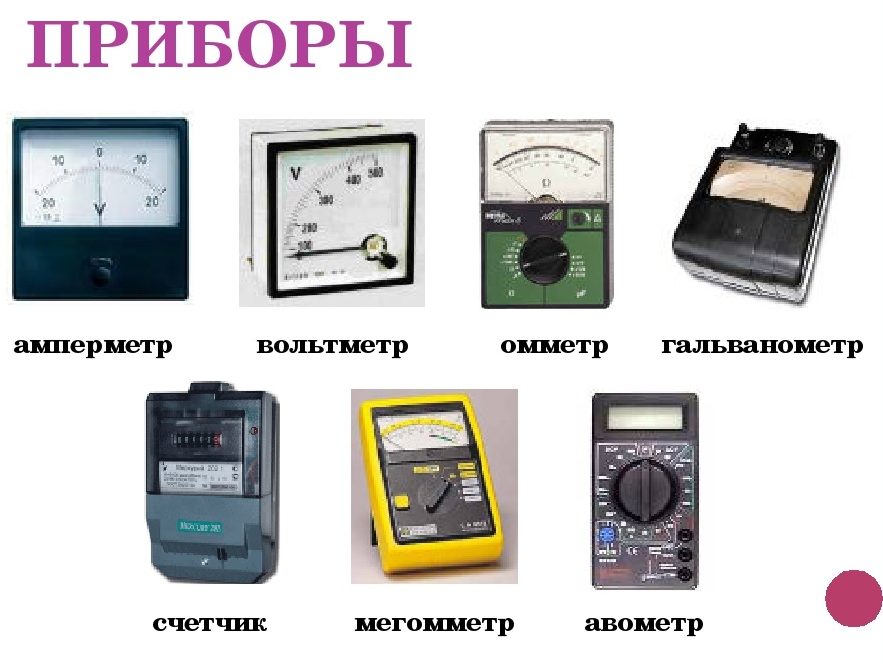
Interesting! In 1920, the British engineer Donald Makadi, a postal worker who maintains communications systems, was pretty tired of all this fuss with a bunch of tools. He developed a universal apparatus - Avometer, with the functions of an ammeter, voltmeter and ohmmeter. Hence the first three letters in its name: Ampere, Volt, Ohm.
The new instrument is a combination of three instruments in one compact body. It is versatile. It can be used to measure all the basic characteristics of an electrical circuit.
It began to be called a multimeter with the advent of digital devices. Analog devices were called testers or "tseshki", since the type marking of the device began with the letter "C".
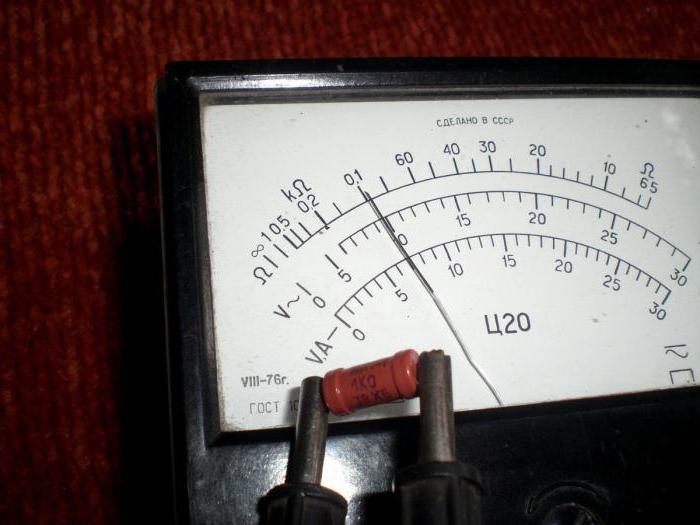
What are the multimeters
Analog and digital are the two main types of devices. In terms of price, accuracy, capabilities, professional and amateur (household) devices are distinguished. These differences are worth reading in more detail.
Analog
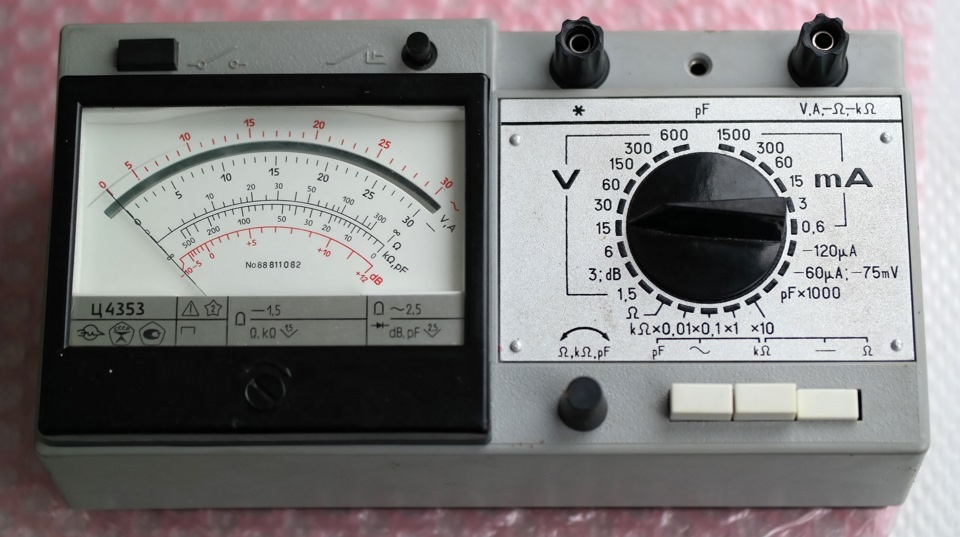
A device with a measuring scale and an indicating arrow. The principle of operation is quite simple. The measuring head of the tool consists of a coil, inside which a rotating frame is installed, mechanically connected with a spring and an arrow. The current passing through the turns of the coil generates a magnetic field in it.
When performing research, the magnetoelectric characteristics of the field change, forcing the frame to rotate at a certain angle, dragging the arrow along with it, which moves along the scale, showing the result.
Analog devices are not very accurate. To some extent, this effect is leveled by trimming resistors. The residual error is not so great that it cannot be neglected. It is best to use a digital multimeter for more accurate results.
Digital

Instruments of this type are more convenient than analog instruments because they do not have a scale and an arrow. They are replaced by a liquid crystal display. The analog signal is processed by an ADC (analog-to-digital converter), converted into a binary code. The result is shown on the display. This is much more convenient than detecting the position of the arrow and calculating the values, taking into account the division and graduation of the scale. And the results are more accurate.
Amateur
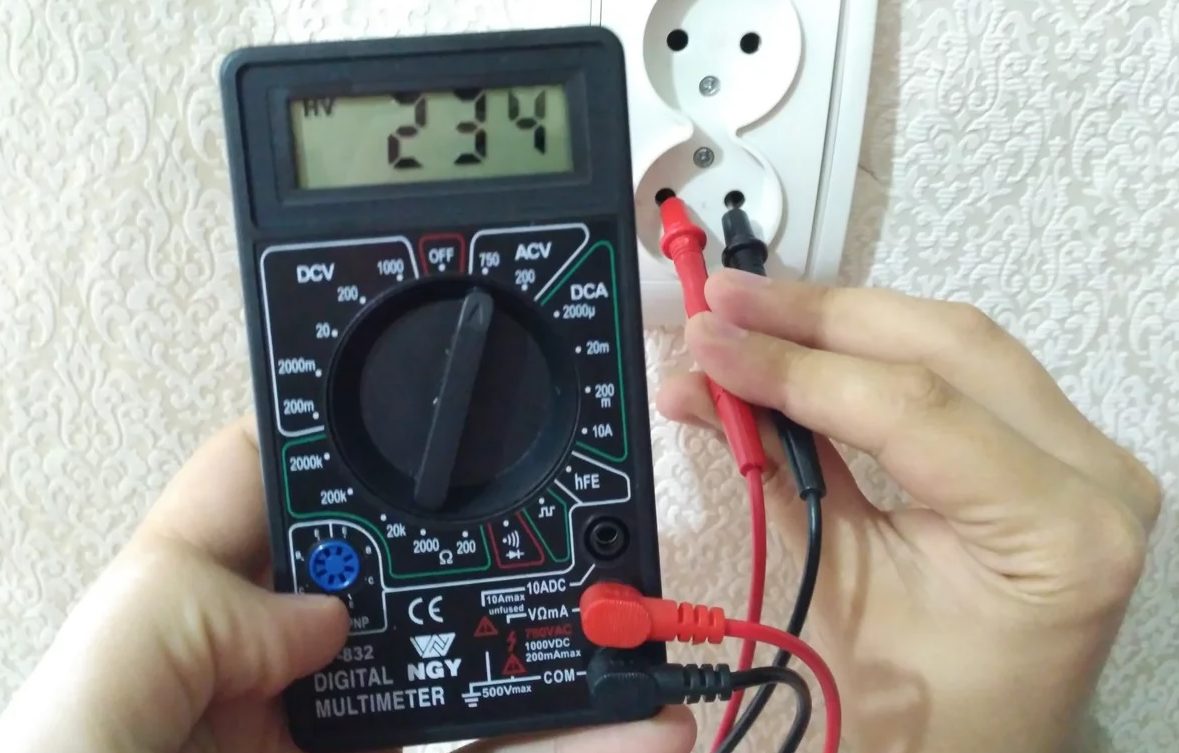
The simplest and most inexpensive device with a minimum set of operations. Designed for infrequent home use: checking the voltage in the network, the health of the light bulb, determining the charge of the battery or accumulator, etc. The dialing mode is very useful for finding damaged conductors of electrical cables.
Professional

To diagnose and repair complex electronic equipment, the capabilities of an amateur tester will not be enough. We need a multifunctional, combined apparatus capable of making numerous measurements every day. In addition to standard operations, they can measure the inductance of coils, capacitance of capacitors, frequency within 10 MHz and temperature, if the package includes a thermocouple. The measuring range of professional products is much wider than that of amateur ones, and the accuracy is higher. Professional devices are reliable, durable and more expensive.
Application area
First of all, it is an electrical measuring instrument. Its main purpose is to determine the parameters of power grids. Experts in the field of radio electronics cannot do without it. Electricians and specialists of the instrumentation and automation service (instrumentation and automation) daily diagnose electrical equipment and automation systems for technological processes using digital and analog testers and current clamps.
The construction business is not lagging behind industrial enterprises in its development. Modern housing and office buildings, shops and restaurants have rather complex engineering networks:
- lighting;
- Power equipment;
- video surveillance systems, security and alarm systems, etc.
All this is equipped with the most modern electronics. Therefore, in construction, high-quality multimeters are needed no less than in the maintenance and repair of industrial equipment.
Modern testers have a lot of useful functions that allow you to use it not only as an electrical measuring tool. Some devices can detect noise, humidity and light levels. Such is, for example, Pro'sKit МТ-1620, manufactured in Taiwan. Such devices can be used to arm safety engineers.
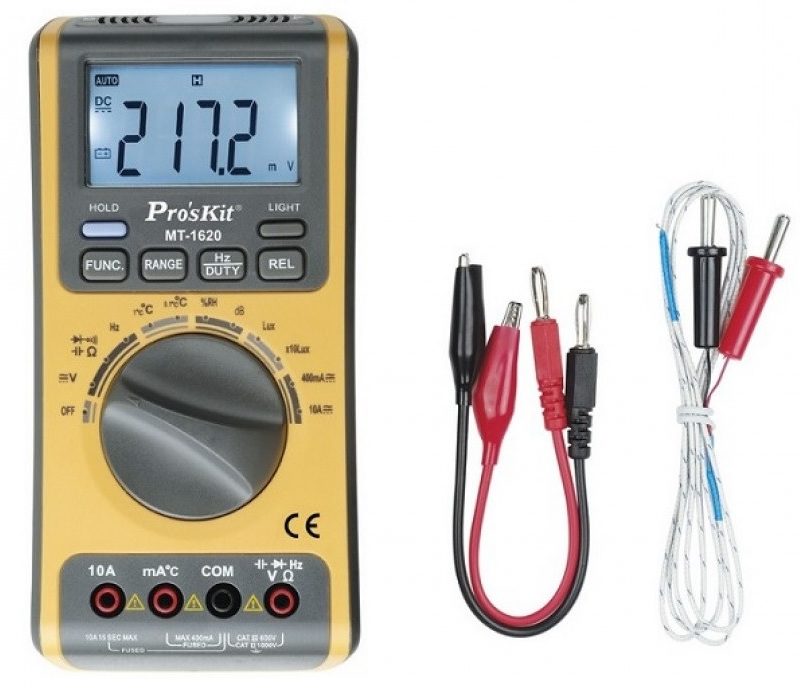
The scope of use of the tester today is unusually wide. Electronics and electrical engineering have firmly entered our lives, and every day they surround us with new useful things that we could not even dream of not so long ago. Setting up and repairing them won't be easy without a tester.
How to use a multimeter
On the front panel of any product there are sockets (at least three) for connecting two wires, black and red. The wires are equipped with plugs for installing them into the sockets, and probes to ensure contact with the investigated section of the circuit. The black (negative) wire plug is inserted into the jack marked with a (-) or the letters "com". The rest of the sockets are intended for the red wire and can be indicated by the symbols of the parameters under investigation.
- Socket # 1 - VΩmA. For measuring voltage (V), resistance (Ω), and current in milliamperes (mA).
- Socket # 2 - COM, for black wire.
- Socket No. 3 - 10 A, to determine the current strength up to 10 amperes.
In the central part of the control panel there is a switch that rotates left and right. Sectors with numerical values are marked around it.
- DCV - sector for research of voltage parameters from DC sources;
- ACV - the same for alternating current;
- Ω - resistance measurement sector;
- A - electric current measurement sector;
One of the switch positions is marked with diode and capacitor symbols. In the same position, the integrity of the conductors is checked (dialing mode).Sometimes this position is also marked with a sound wave symbol. This means the device beeps in this mode. It's comfortable. Hands and eyes are busy keeping the tester in contact with the leads. If there is no break, a "melodic squeak" is heard.
Each sector is divided into sub-ranges, indicated by the numerical values of the maximum value of the measured parameter
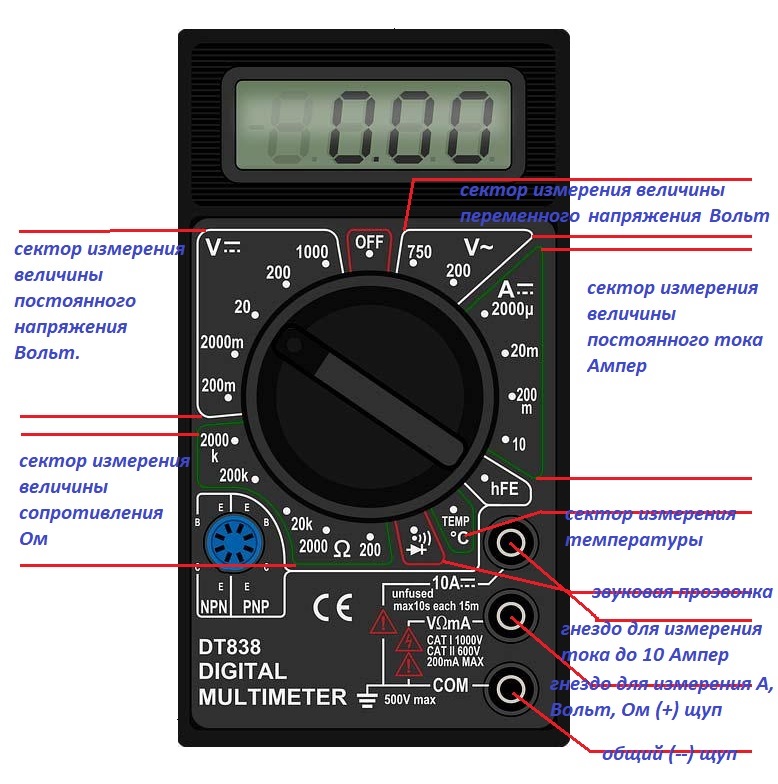
Important! Any measurement must be performed by setting the switch to the position of the maximum value of the measured parameter.
We measure the voltage
The simplest operation. The range selector is switched to the DCV (direct current) sector to examine batteries and accumulators, or to the ACV sector to determine the actual voltage in the AC mains (in the home outlet). Then the switch is set to the position of the maximum parameter value. For example, you need to determine the status of a AA battery (1.5 V). The switch is set to 2000 mV (2.0 V). The probe of the red wire is pressed against the positive pole of the battery, the black one - against the "minus".
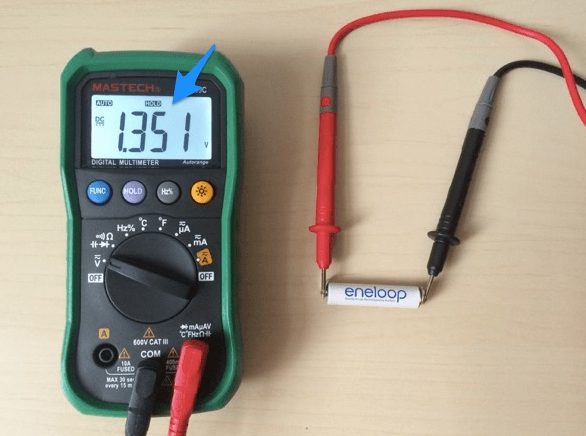
The display shows a value of 1.351 V. The battery is normally charged and operational.
If you turn the switch to 200 mV (0.2 V) and repeat the measurement, the display will show the value "1". This means that the selected range is significantly less than the investigated parameter. If, when determining the battery charge, a value with a minus sign appears on the display, the user has reversed the polarity. The tool will not deteriorate from this, and the owner will understand that he has confused a minus with a plus.
Resistance test
The switch is set to the Ω sector, the maximum value is selected, say 2000 k (kilo-ohms). The probes are pressed against the terminals of the studied resistor. If the numerical value on the screen is too small (thousandths), the selected sub-range is too large. The switch is moved to the next position, the experiment is repeated. With each measurement, the accuracy of the result increases.
Each resistor may have deviations from its value, expressed as a percentage. It looks like this: 200 kΩ ± 15%. Analyze the result with a tolerance. If the deviation is much greater than it, the resistor is defective.
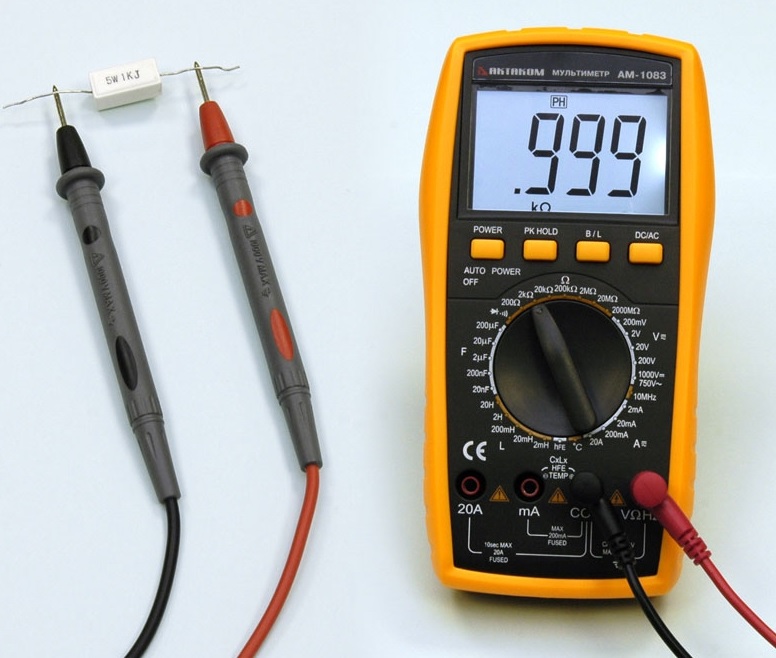
Checking variable resistors is performed in several steps. First, the nominal value of the parameter is measured (between the two extreme terminals). Then the resistance between the middle and extreme terminals is measured in turn. In this case, the axis of the resistor rotates smoothly. The result should vary from zero to maximum.
Important! Such measurements are best done with an analog instrument. It is more convenient to observe the smooth movement of the arrow on the scale than to track the flickering numbers on the display screen.
How to measure current
To determine the value of this parameter, the apparatus must be "embedded" into the circuit. For example, the resistor we have already investigated is pressed with one lead to the positive pole of the battery. This is already a diagram. It remains to apply one probe to the negative pole of the battery, the other to the free terminal of the resistor. The position switch must be at the maximum value.
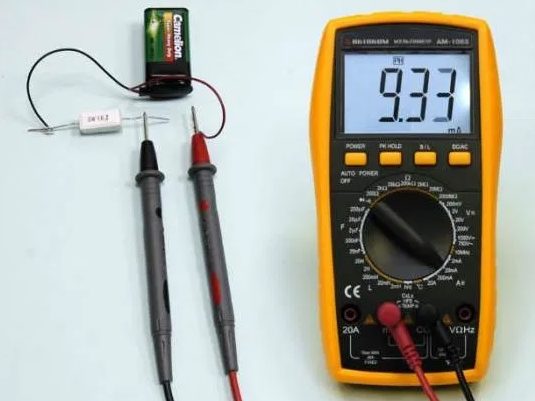
Criterias of choice
How to choose a multimeter for your home if you have never used one? For such cases, there are certain criteria worthy of detailed consideration.
What is the device for?
If the user is not going to repair complex electronics, it makes no sense to buy an expensive tester with the ability to determine the frequency, capacitance of capacitors, temperature, etc. It is enough to purchase an inexpensive digital instrument with three basic functions. With it you can always determine the charge of the battery or battery, ring the cable, incandescent lamp, heating element, etc.
Ensuring safe operation of the device
The purchased tester must withstand the maximum loads of the networks for which it is purchased. The safety of its owner depends on it. According to the international standard IEC1010-10, devices are divided into four categories according to the level of electrical safety, with the corresponding designation on the panel:
- CAT I, for testing low voltage circuits of electronic devices.
- CAT II.Suitable for measurements inside the apartment, but only up to the switchgear.
- CAT III. A tester with such protection can investigate the parameters of inter-floor distribution networks.
- CAT IV is used to inspect outdoor power grids.
For domestic use, select devices of category II and III.
Probe requirements
The probes are in direct contact with the wearer's hands and the loaded conductor. Their handles are insulated. Safety category and load rating information is printed on the handle. A protective protrusion on the handle protects the wearer from accidentally touching the contact part.
Important! It is forbidden to work with probes, the insulation of which is damaged. They need to be replaced with new ones whose electrical characteristics correspond to the product safety category.
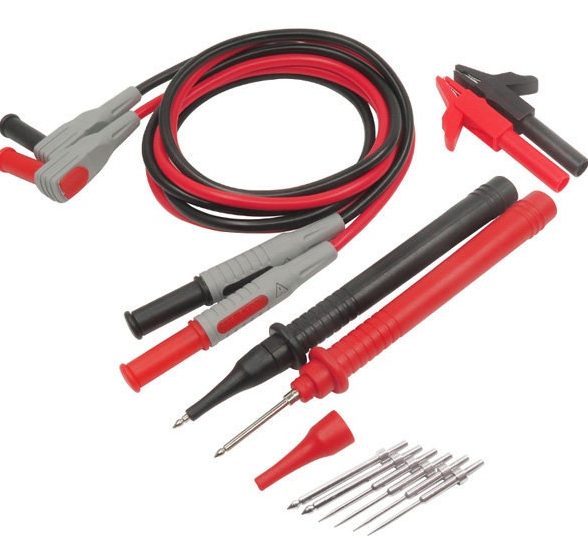
Choice by price
Basic measurements can be performed with any tester. The tester for home use, will not bring profit to the owner by definition. Therefore, you need to choose an inexpensive device. The value of the instrument is determined by its functionality:
- accuracy class;
- the presence of built-in memory to save the latest measurement results;
- fixing the results;
- the ability to study the parameters of capacitive equipment, inductance, frequency and temperature.
A particularly precise instrument is not needed for domestic use. The cheapest digital multimeter has such a minimal error that you can ignore it. The need for the rest of the features listed above is up to the purchaser.
In any case, it is better to give preference to mid-range testers. They are accurate enough, hardy, and can last a long time. If some operations seem unnecessary at first, it is possible that over time the user will gain experience and appreciate them.
What else to pay attention to
In addition to the basic ones, modern digital devices have useful additional features:
- display backlight;
- NCV - detects the presence of voltage in the conductor when approaching, without making direct contact, which significantly increases the safety of the user;
- a dial tone with a sound signal, which allows to determine the presence of a break in the cable or a malfunction of the incandescent lamp "by ear";
- HOLD – fixation on the display of the last result is very convenient when the numerical value of the measured parameter needs to be written down or memorized;
- automatic range setting allows you to set the switch only on the measured parameter, and there is no need to select its maximum numerical value, since the tester does it on its own.
Important! Information about entering the tester into the State Register of Measuring Instruments is of interest to professional electricians. Such instruments must undergo periodic verification in certified laboratories, with the execution of the relevant acts.
A registration certificate is optional for a home instrument.
The presence of additional functions makes the use of the tool as convenient and productive as possible, while increasing its cost.
Top manufacturers
- ABB. Sweden / Switzerland. Specialization: electrical engineering, power engineering, information technology. Manufactured in Europe, Asia. USA and Brazil.
- UNI-T, China. The largest manufacturer of power tools in Asia. UNI-T products are inexpensive testers with good functionality.
- Testo, Germany. On the market since 1957. Initial specialization - production of honey. technology. In the 70s, the company begins to produce control and measuring devices. Popular Testo models are in high demand among professionals.
- Stanley, USA. Has been manufacturing measuring tools since 1843.Today, this powerful corporation produces high quality, durable professional tools.
- Fluke, USA. The company is one of the world leaders in the design and manufacture of digital testers. The popularity of the models is explained by the high build quality, ease of use, and long-term operation.
- Mastech, Hong Kong. Specialization: current clamps, power supplies, multimeters. Inexpensive and high quality models.
- Victor. The trademark owner is the American company Victor Electronics. Specialization: current clamps, multimeters, tachometers. Manufactured in China. Victor - high quality budget devices.
- Hioki, Japan. One of the largest companies in the world for the production of testers, clamps, etc.
- Bison. Russian manufacturer of tools for DIYers. High-quality and inexpensive models are in demand in the domestic market.
These are not all manufacturers of quality testers. Which company is better to buy is up to you. Listen to the recommendations of experienced users, find out how much the model you like costs and make a decision.
Where can I buy
Budget models can be found at any building tool store. If a specific model is required, it is better to order it online from an online store. A list of them can be found on Yandex-Market by typing the name of the model in the search bar.
Before buying, you should collect all the information about the device you are interested in, listen to the advice and recommendations of experienced craftsmen, study the description of the device, its characteristics, find out how much it costs and make a decision.
Rating of quality multimeters
10. Elitech MM 100
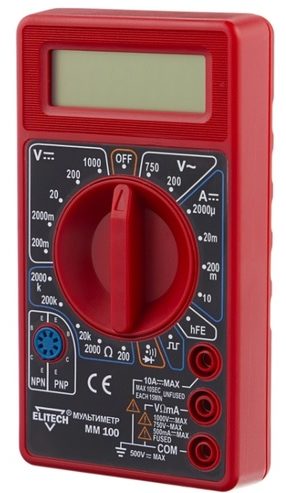
The review opens the inexpensive model ММ100 of the Russian brand Elitech. For just 280 rubles, you can measure everything you need in the house, in the country or in the car. The quality of the wires is poor. Experienced users advise to change them immediately. Product reviews are generally positive. Radio amateurs can check transistors, diodes, resistors. The ringing sound is weak, but it is there. Not a bad option for home use.
Advantages:
- availability of all basic functions;
- dial tone with sound;
- affordable price.
Disadvantages:
- weak dial tone.
| Model name / brand name | Specifications | average price |
|---|---|---|
| Elitech ММ 100 / Russia | Powered by element 6LR61, 9V. Measurement of AC (up to 750 V) and DC (up to 1000 V) voltage with an error of 2%, current (up to 1000mA), resistance up to 2 MΩ. Checks diodes, transistors for breakdown, rings the conductors. Includes two wires with probes. | 280 rubles |
9. IEK Compact M182

Another device developed in Russia. The software of the international standard IEC1010-10 corresponds to the second category of safety (CAT II). The range switch is clearly fixed in the selected position. The body is made of good plastic, durable. The device is compact, pocket-sized, but it makes measurements quite accurately. The error does not exceed 1%. Not a bad device for little money.
Advantages:
- compact size;
- sounded dial mode;
- inexpensive.
Disadvantages:
- the quality of the wires is poor;
- dial tone is weak.
| Model name / brand name | Specifications | average price |
|---|---|---|
| IEC Compact M182 / Russia | Dust and moisture protection class IP20. Measurements DCV from 0.2V to 500V, ACV - 200V and 500V, current from 2 to 200mA, resistance - up to 2MΩ. Modes of checking diodes, transistors, dialing with sound. Includes two wires with probes. | 342 rubles |
8. Bison MX-600
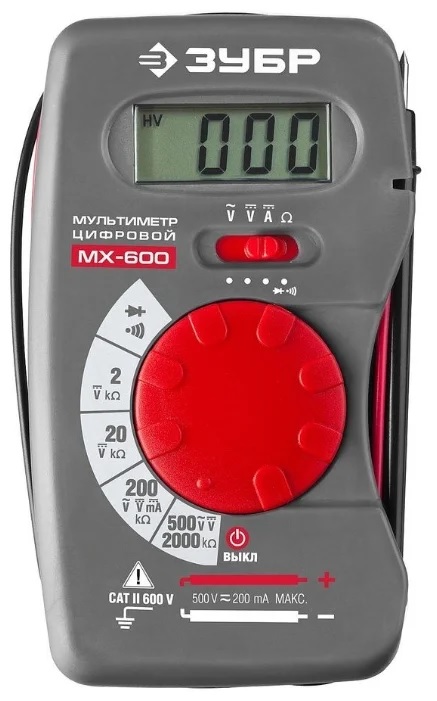
Simple tester for very modest money. The design is unusual. The wires are soldered to the board. On the one hand, there is no longer the need to stick them into the connectors and remove them from there at the end of the work. Problems will arise when there is a desire to replace them. The selection of sub-bands is made with a round switch, and the network parameters themselves - with a slide switch under the display screen. The Bison MX-600 copes well with its work and is inexpensive, only 280 rubles.
Advantages:
- very affordable price;
- compact size;
- takes all basic measurements.
Disadvantages:
- short integral wires.
| Model name / brand name | Specifications | average price |
|---|---|---|
| Bison MX-600 / Russia | Power supply - element 23A, 12V. Safety category CAT II. ACV / DCV measurements up to 500 V, current up to 200mA, resistance up to 20,000 kOhm. Diode test modes, sounded continuity. The wires with the probes are soldered to the board. | 280 rubles |
7. UNI-T UT 33A
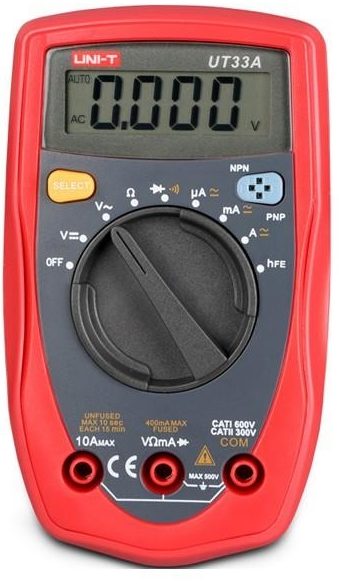
A small tester from a reputable Chinese manufacturer. Measures all parameters with sufficient accuracy for the home. The first device with automatic range selection in the review saves the user from unnecessary manipulations, sometimes erroneous, as a result of which the devices fail. The wires are quite good. Plugs fit snugly in sockets, contact parts are solid. Case material - high quality plastic.
Advantages:
- high quality wires;
- durable body;
- automatic range selection.
Disadvantages:
- no screen backlight.
| Model name / brand name | Specifications | average price |
|---|---|---|
| UNI-T UT33A / China | Measures DCV up to 500V, ACV up to 500V, amperage no more than 10A, resistance of conductors and resistors up to 40MΩ. Tests diodes and transistors. Continuity mode with sound. The measuring range is selected automatically. Includes two wires with probes. | 700 rubles |
6.CEM DT-912
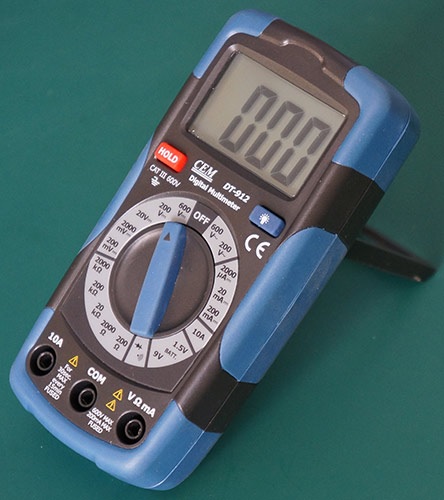
One of the leaders in the production of measuring equipment in the Asian market, the Chinese company Shenzhen Everbest Mashinery CO, is presented in the review with the CEM DT-912 model. A budget digital device with standard features in a rugged rubberized case. The screen is large, backlit and large numbers. Powered by the Krona battery. Overload protection is provided by two fuses, 10 A and 200 mA. The dial tone is loud, the wires are of high quality. There is a retractable stand on the back of the case. Very handy thing for working at the table. The average price is 1,029 rubles. An excellent device for the home.
Advantages:
- comfortable, durable body;
- loud dial tone;
- large display with large numbers and backlight.
Disadvantages:
- manual range selection.
| Model name / brand name | Specifications | average price |
|---|---|---|
| CEM DT-912 / China | Measurement of ACV / DCV up to 600 V, current up to 10 A, resistance up to 2 MΩ. Modes of checking diodes, transistors, dialing with sound. Manual range selection. Includes two wires with probes. Additionally: screen backlight, measurement fixation. | 1029 rubles |
5.PM 19 Peakmeter
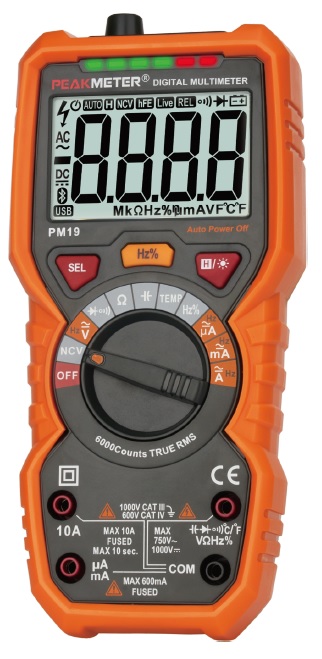
The Chinese company Peakmeter in our review is represented by the PM 19. The case is made of durable plastic in a rubberized shell. The set of standard operations is supplemented with the ability to determine the frequency and temperature, record the result (HOLD), indicate overload and battery charge level. Range selection is automatic. The display is large, backlit and large numbers.
Advantages:
- durable, ergonomic body;
- large backlit display;
- extended functionality;
- automatic range selection.
Disadvantages:
- not identified.
| Model name / brand name | Specifications | average price |
|---|---|---|
| PM 19 Peakmeter / China | Measurements DCV up to 1000 V, ACV up to 750 V, current up to 10 A, resistance up to 60 MΩ, frequencies up to 10 MHz, temperatures up to 1000 ° C, Tests diodes and transistors. Continuity mode with sound. The range is selected automatically. Equipped with add. functions of display backlight, recording of results, indication of overload and battery charge. Supplied with two wires with probes and a thermocouple. | 1714 rubles |
4. Mastech MS 8229
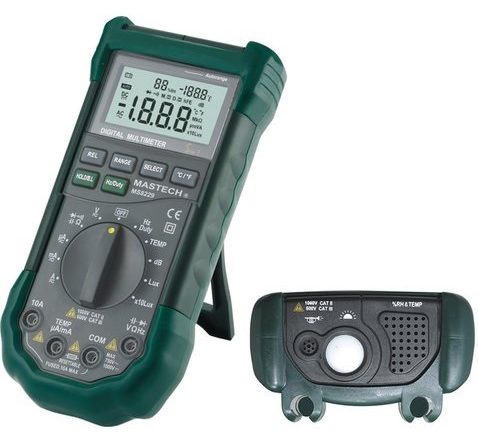
Product of a well-known Hong Kong company. Wide range of basic measurements. In addition to them, you can measure humidity, frequency, temperature, illumination and noise load (pocket laboratory of industrial sanitation). Robust case. Large backlit screen. The range is selected automatically and manually (if necessary). The device is included in the State Register, is subject to periodic checks and can be used in professional activities to issue official measurement protocols.
Advantages:
- durable body;
- large display;
- an impressive set of functions and capabilities;
- inexpensive.
Disadvantages:
- not identified.
| Model name / brand name | Specifications | average price |
|---|---|---|
| Mastech MS 8229 / Hong Kong | Measurements DCV up to 1000 V, ACV - up to 750 V, current up to 10 A, resistance within 40 MΩ, frequency up to 100 kHz, temperature up to 1000 ° С, illumination - up to 40000 lux, humidity - in the range from 20 to 95%, sound loads in the range from 40 to 100 dB. Modes of checking diodes, transistors, dialing with sound. Redistribution of measurements is selected automatically. There is a screen backlight, fixation of results, indication of overload and battery charge. Includes probes, thermocouple. Powered by 3 AAA batteries. | 5145 rubles |
3. Testo 760-1
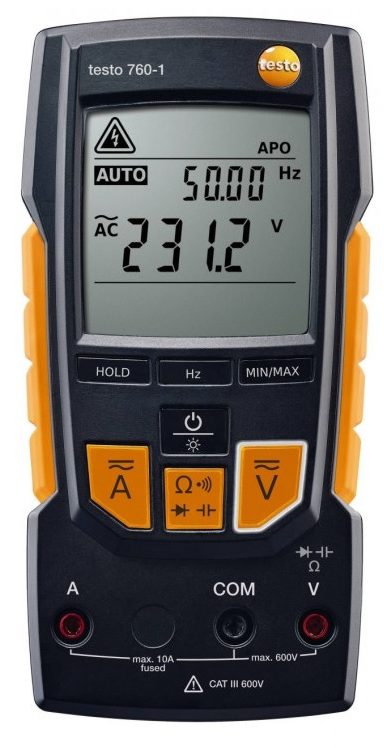
Professional digital tester of high quality, middle price segment, with a set of standard operations. The range is selected automatically. The device differs from the models of other manufacturers in the absence of a rotary switch. The parameter is selected by pressing one of the three keys in the central part of the case. Each of them is marked with appropriate symbols. By pressing the right key again, you can enter manual mode.
The display is very large, 5.5x5.5 cm. Under its lower edge there are three small buttons for turning on the Hold functions (fixing the last result), determining the frequency, minimum and maximum values of the parameter under study.
High quality test leads with long leads. On the back of the case there are slots for attaching them. For their connection to the device, there are three slots on the front side of the case. The set includes rubber plugs designed to protect the jacks from dust and moisture. The device is included in the State Register.
An excellent professional tool for a reasonable price.
The Testo 760-1 is the youngest product in this line. Its older "brothers": Testo 760-2 and 760-3 are distinguished by the presence of a kind of dynamic scale at the bottom of the display (like analog testers). Older devices cost two and three times more, respectively.
Advantages:
- durable, ergonomic body;
- original design;
- large display with bright backlight;
- acceptable price.
Disadvantages:
- no thermocouple included.
| Model name / brand name | Specifications | average price |
|---|---|---|
| Testo 760-1 / Germany | Measurements of ACV / DCV up to 600 V, current up to 10 A, resistance up to 40 MΩ, frequency up to 0.514 MHz, temperature, capacitance up to 100 μF. Checks diodes and transistors, rings the conductors. Automatic selects the measurement limit. Includes two wires with probes. Additional functions of measurement fixation and screen illumination. Listed in the state register of measuring instruments. | 6599 rubles |
2. Laserliner Multimeter Poscet XP
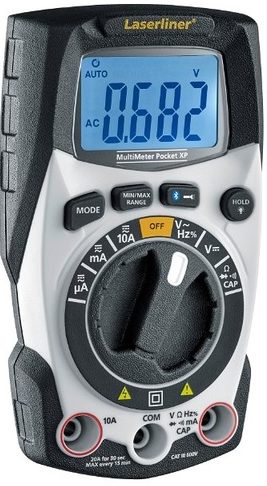
The German company Laserliner is no longer a newcomer to the measuring instrument market. Its products are in high demand among professionals around the world. Laserliner products appeared on the domestic market in 2018. In our review it is represented by the Multimeter Poscet XP model. Professional tool with a full range of necessary operations. Automatic range selection. A traditional rotary switch for parameter selection is located in the central part of the case. The large display screen is backlit. Additional functions:
- Hold (fixing the result);
- data transmission via Bluetooth;
- frequency measurement;
- built-in flashlight.
An excellent device for the home.
Advantages:
- comfortable, durable body;
- automatic range selection;
- large backlit display.
Disadvantages:
- when measuring some parameters, the error is large.
| Model name / brand name | Specifications | average price |
|---|---|---|
| Laserliner Multimeter Pocket XP / Germany | Measures DCV and ACV up to 600 V, current up to 10 A, resistance up to 40 MΩ, frequency up to 0.01 MHz, capacitance up to 4000 microfarads. Modes of checking diodes, transistors, dialing with sound. The measuring range is selected automatically. Includes two wires with probes. Additional functions of fixing measurements and screen illumination, data transmission via Bluetooth, flashlight. | 7439 rubles |
1. Fluke 17B +
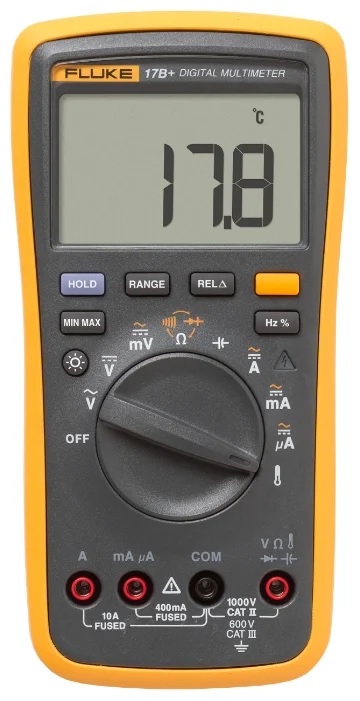
The best reviews from professionals are received by the products of the American company Fluke. In our review, it is represented by the Fluke 17B + model. The robust casing is enclosed in a rubberized sheath that complies with IP40 ingress protection.Batteries - two AA batteries. The set of functions is standard. Range selection is automatic. The required parameter is selected with a rotary switch.
The display is large, the backlight is bright. To view the maximum and minimum results, there is a button with the corresponding symbols. Quality probes, with protective caps to protect against short circuits. The wires are long and soft. A very high quality device, equally useful for amateurs and professionals.
Advantages:
- robust housing, protected from dust and moisture;
- large display, bright backlight;
- automatic range selection;
- clear instructions.
Disadvantages:
- not identified.
| Model name / brand name | Specifications | average price |
|---|---|---|
| Fluke 17B + / USA | Measurements of ACV and DCV up to 1000 V, current up to 10 A, resistance up to 40 MΩ, frequency up to 0.1 MHz, capacitance up to 1000 μF. Modes of checking diodes, transistors, dialing with sound. The range is selected automatically. The set includes two wires with probes, a thermocouple. Additionally, the functions of fixing measurements and screen backlighting. | 7439 rubles |
The multimeter is a very useful tool for home and professional use. The number of manufacturers and the operating stuffing of the models may confuse a newbie looking to purchase this device. The editors of the site hope that our review will help future users find answers to most of the questions that arise and not make mistakes when choosing the right option.












